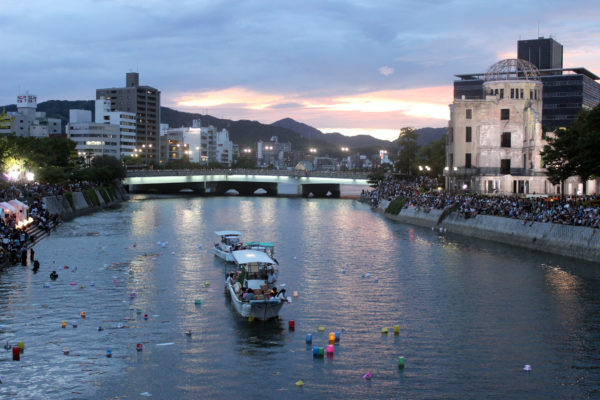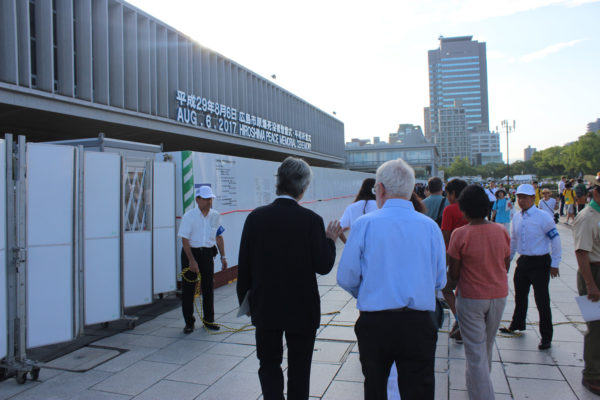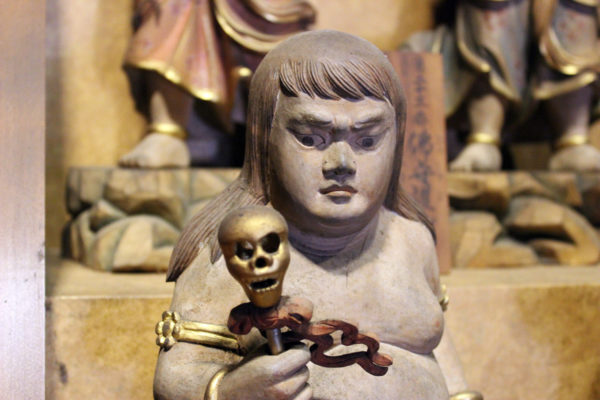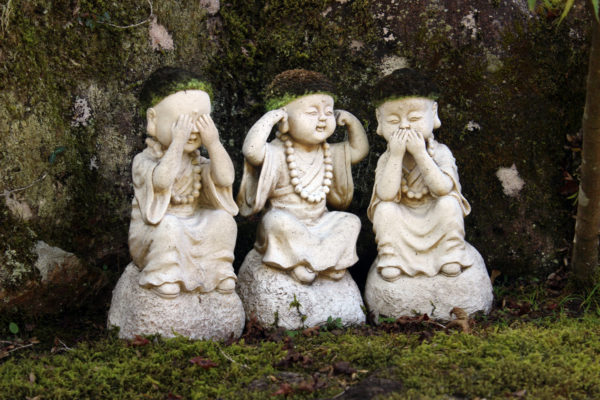I am writing this blog post while on a bullet train between Hiroshima and Kyoto, having spent the last seven days in the city that was, 72 years ago, destroyed by the first atomic bomb, but was reborn as something quite vibrant and alive. I intend to write several blog posts about my visit to Japan; this first one focuses on the more formal academic issues that have come up during my stay in Hiroshima.
After a very long plane ride (though frankly I have been on worse ones — ANA, like most foreign air carriers, puts American air carriers to shame), I am in Japan. This visit is part work, part tourism; work provided the excuse to come (and helped defray much of the cost), but as someone who has spent so much time writing and teaching about Japan, especially in the context of World War II, it seemed an absolute requirement that if I could make the time for it, that I ought to spend more time here. So I am staying in country until August 13th, splitting my time between Hiroshima, Kyoto, and Tokyo.

The beginning of the Hiroshima lantern lighting ceremony, August 6, 2017. These photos are all from my trip. Photo by author.
The main “work” reason for coming to Japan was to participate in a conference hosted by Princeton University and the Prefecture of Hiroshima called “Global Hiroshima: The History, Politics and Legacies of Nuclear Weapons,” as well as to sit in on the “Hiroshima Roundtable.” The former conference focused on the history and legacy of the atomic bomb decision, whereas the latter was focused more on the present day and future of nuclear weapons. Both were of immense interest and I am extremely grateful to Princeton and the Governor of Hiroshima Prefecture for making them all happen (and especially to the indispensable Cynthia S. Ernst and Takuya Tazawa, who together made this trip so much easier than I think it otherwise would have been).
The Roundtable involved an interesting number of political scientists and a few historians, representing at least seven countries. The US representatives, John Ikenberry, Jeffrey Lewis, and Scott Sagan, are all heavy-hitters, and there were a handful of other Americans there (myself included) as observers. The discussion focused on major questions related to the future of nuclear weapons, with three issues really taking center stage.
One was North Korea, whose missile capabilities seem to grow by leaps and bounds each week. I have personally felt, and was glad that other more informed people seemed to feel the same way, that the current US rhetoric about finding a “solution” to the problem of the North Korean ICBM capability seems both misguided and terrifying. (The North Koreans have made very clear that they would consider any attempt at a “decapitation” of any sort of their high leadership as a “line” that, if passed, would result in a nuclear response against either the United States or its allies. I see no reason not to believe them.) I feel quite strange arguing that the old Cold War policy of “containment” seems like a better solution, but really almost anything seems like a better solution that starting (yet another) war, much less one with a state whose nuclear capabilities are not as trivial as people make them out to be. (These discussions inspired me to make some real progress on my new MISSILEMAP web application which I will be launching very soon, with any luck.)

A koi feeding frenzy in the Shukkei-en park, which was completely destroyed by the bombing, but, like most of Hiroshima, eventually rebuilt. The Japanese translate the koi as “carp,” and the Carp is the baseball team of Hiroshima. Photo by author.
Another issue that ran through these discussions was the precarious position of the US leadership in nuclear matters. I have been asked several times over the past few months what I, personally, am “afraid of” — i.e., what looms highest on my list of “threats” at the moment? I’m not sure (we live in a world where many very unpleasant possible future paths are acutely visible), but I will say that if the question is which nation do I think is most likely to defy the “nuclear taboo” in the next few years, the United States has shot to the top of the list. Aside from the rather disturbing research by Scott Sagan and Benjamin Valentino which was published last week, which indicates significant American public support for the use of nuclear weapons against Iran (a “clear majority” would be willing to kill millions of Iranians, if they believed it would save a much smaller number of American lives, and even more Americans would be willing to kill 100,000 Iranians if they thought it would “intimidate” Iran into surrendering in a war), nothing I have read and seen about the Trump administration has reassured me that the adults are running the show.
It is hard to believe that a President who cannot follow a rather simple conversation about policy is going to be able to make good decisions on nuclear matters, and I am not as optimistic as many about the supposed restraining force the military would play, or any other imagined restraining force (fear of impeachment, Twenty-Fifth Amendment, etc.). I hope I am wrong, but it seems a dark thing when Kim Jong-un seems like a more traditional “rational actor” (in the sense that his actions seem quite in line with deterrence theory, and you can see the logic of them, even if you don’t agree with them) than the sitting US President.

A small group of the conference attendees stayed in Hiroshima a few more days, to attend the anniversary ceremonies. Here, from behind, I am following Kiichi Fujiwara, David Holloway, and Shampa Biswas into the seating area. Photo by author.
But most of the discussion was focused on the Treaty on the Prohibition of Nuclear Weapons passed a few weeks ago (and which the nuclear-weapons states and those under their nuclear umbrellas predictably did not sign). I’ll admit I haven’t wrapped my head fully around that yet — I’ve read some of the arguments for and against it, and given that I have not yet wrapped my head around whether pushing for nuclear disarmament is a good idea (I can see the arguments for and against it very clearly, and am truly not sure whether total disarmament leads to a safer world than, say, a minimal deterrence posture), I suppose that is not a surprise.
But the position emphasized at the Roundtable, though, was one I hadn’t thought about at all: that this Treaty is a reflection of a growing chasm between the nuclear-weapons states and the non-nuclear weapons states. The Nuclear Non-Proliferation Treaty, for example, requires relatively close cooperation between these two groups, even as it maintains that they retain different legal statuses. As an American, it is easy to assume that the non-nuclear weapon states recognized, even when they signed it but certainly now, that the United States had no real interest in total nuclear disarmament. That much has always seemed obvious, and it is clear that from the beginning the US regarded the NPT’s requirements for the nuclear-weapon states to pursue “negotiations in good faith on effective measures relating to the cessation of the nuclear arms race at an early date and to nuclear disarmament” as extremely non-binding.1

One of thousands of statues at the Daisyoin buddhist shrine complex on the island of Miyajima, about a 30 minute boat ride from Hiroshima. The specific symbolism is unknown to me, but those who study nuclear matters often find themselves contemplating skulls. Photo by author.
But if the non-nuclear weapons states grow frustrated enough with the lack of progress (and the current nuclear “modernization” programs pursued by the major nuclear powers can be easily read as flying right in the face of NPT’s Article VI), what will the results be? I don’t know, and it seems like a development that bodes ill for the long-term goals of arms control, yet another tension that has been a long time simmering, perhaps put temporarily on hold during the hopeful aspects of the Obama administration, but back with a vengeance once those hopes were not realized, and in the face of the present “America first” position on foreign policy.
The historical workshop, “Global Hiroshima,” was quite interesting as well. Along with the people already mentioned, there were a great number of others as well: Michael Gordin (Red Cloud at Dawn), Frank Gavin (Nuclear Statecraft), David Holloway (Stalin and the Bomb), Nina Tannenwald (The Nuclear Taboo), Mark Walker (Nazi Science), Sean Malloy (Atomic Tragedy), Shampa Biswas (Nuclear Desire), Campbell Craig (The Atomic Bomb and the Origins of the Cold War), Sonja Schmid (Producing Power), among others, and a wonderful group of Japanese scholars whose work I (and presumably most American scholars) are less familiar with: Yukiko Koshiro, Wakana Mukai, Takuya Sasaki, and Kiichi Fujiwara, among others. For my own part, I gave the latest version of my research into the sparing of Kyoto. My thoughts on it have evolved since I first wrote about them on this blog; the blog post has aged reasonably well, in my mind, though there are a few things I have nailed down that I did not have at the time. (More on this in a future post.)

Three of the many, many statues of “Jizo” scattered around the Daisyoin complex on Miyajima. The baby-like monks are all wearing knit caps or bibs, usually bright red (these ones are unusual in that they have been allowed to grow moss), and are apparently doted upon by parents who have lost children. Photo by author.
Of the papers (that I cannot hope to do justice in a brief summary), a few brief thoughts on the ones that stuck out to me, to give a flavor of the proceedings: Campbell Craig had a very ambitious paper which attempted to parse Franklin Roosevelt’s feelings about the atomic bomb as an instrument of national strategy, a matter of particularly interesting difficulty given how little of his thinking on this topic Roosevelt shared with others, but I thought the effort interesting and credible (e.g., Craig looked closely at Roosevelt’s lack of interest of communicating with the Soviets on the matter, even though he had been told that they had penetrated the project with espionage); Sean Malloy’s paper on the issue of racism and the use of the atomic bomb was provocative and gave me much to think about; Yukiko Koshiro’s discussion of pre-August 1945 projections by the Japanese military about the Soviet entry into the war was new to me (much of it apparently is discussed in her book published a few years ago) and really strengthened, in my mind, Tsuyoshi Hasegawa’s contentions (even as it brought up some contradictions and questions; this is perhaps a subject for another blog post); Nina Tannenwald’s paper on the future of the “nuclear taboo” (the belief that nuclear weapons cannot be used, not just the act of non-use) was important if depressing (there are some worrying indications, as noted already); Kiichi Fujiwara’s discussion of the changing ways in which the Japanese people have viewed Hiroshima (it did not become a “special” city to them until the Bravo accident in 1954, which I thought was interesting), and the way its role in Japanese domestic political discourse has shifted over the decades, was a particularly appropriate and important way to end the conference. There were many other interesting papers, to be sure (two, Holloway’s and Schmid’s, looked at the Soviet context, while others looked at the postwar nuclear situations of Brazil, Japan, and West Germany); these are the ones that meshed most closely with my present interests (and my ability to process new information — the jet-lag has not been as bad as I thought it might be, but it’s been a factor).
The conference, in a sense, was quadruply juxtaposed. You had the juxtapositions of nationalities (not just American and Japanese, but several others as well: Australia, UK, Sweden, Brazil), and juxtapositions of specialties (political scientists and historians were both heavily represented in several different flavors, but there were other approaches on offer as well). Does traveling to Japan change the discourse of American scholars? Could we have had this same conference in New Jersey, to the same effect? In some sense, yes; the conversation was entirely in English, considered many of the same topics that we tend to talk about whenever this sort of group comes together (and a nearly identical group had a similar conference in 2015, in Princeton). On the other hand, there is something more resonant and “destabilizing” to have these discussions in a different context, and especially of that context is Hiroshima itself. Historians, at least, will almost always agree that context matters, that who is in the room, and where the room is, affects what is said and thought in the room. As one elderly Japanese man remarked to me and my wife when we visited Shukkei-en, a historic garden in Hiroshima, “there are many sad stories here.”
I will try to write at least two more posts while I am here: one on my thoughts on being in Hiroshima on 72nd anniversary of the atomic bombings, and another on my latest findings on the sparing of Kyoto and its impact on nuclear history.
- Article VI of the NPT states: “Each of the Parties to the Treaty undertakes to pursue negotiations in good faith on effective measures relating to cessation of the nuclear arms race at an early date and to nuclear disarmament, and on a treaty on general and complete disarmament under strict and effective international control.” At the NPT Review Conferences, the US typically points to progress made in arms reductions since the Cold War, and its willingness to enter into discussions on various treaties, as a sign of its good faith negotiations. My understanding is that the most recent NPT Review conference, in 2015, was marked with unusual lack of consensus. [↩]


